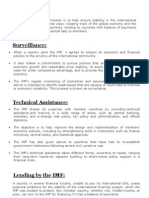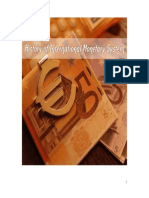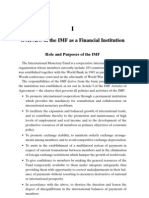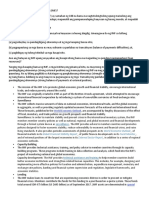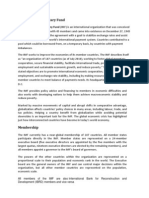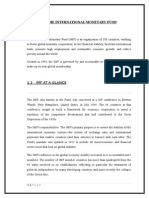Surveillance
Surveillance
Uploaded by
Bianca BiaCopyright:
Available Formats
Surveillance
Surveillance
Uploaded by
Bianca BiaOriginal Title
Copyright
Available Formats
Share this document
Did you find this document useful?
Is this content inappropriate?
Copyright:
Available Formats
Surveillance
Surveillance
Uploaded by
Bianca BiaCopyright:
Available Formats
Our Work The IMF's fundamental mission is to help ensure stability in the international system.
It does so in three ways: keeping track of the global economy and the economies of member countries; lending to countries with balance of payments difficulties; and giving practical help to members. Surveillance When a country joins the IMF, it agrees to subject its economic and financial policies to the scrutiny of the international community. It also makes a commitment to pursue policies that are conducive to orderly economic growth and reasonable price stability, to avoid manipulating exchange rates for unfair competitive advantage, and to provide the IMF with data about its economy. The IMF's regular monitoring of economies and associated provision of policy advice is intended to identify weaknesses that are causing or could lead to financial or economic instability. This process is known as surveillance. Country surveillance Country surveillance is an ongoing process that culminates in regular (usually annual) comprehensive consultations with individual member countries, with discussions in between as needed. The consultations are known as "Article IV consultations" because they are required by Article IV of the IMF's Articles of Agreement. During an Article IV consultation, an IMF team of economists visits a country to assess economic and financial developments and discuss the country's economic and financial policies with government and central bank officials. IMF staff missions also often meet with parliamentarians and representatives of business, labor unions, and civil society. The team reports its findings to IMF management and then presents them for discussion to the Executive Board, which represents all of the IMF's member countries. A summary of the Board's views is subsequently transmitted to the country's government. In this way, the views of the global community and the lessons of international experience are brought to bear on national policies. Summaries of most discussions are released in Public Information Notices and are posted on the IMF's web site, as are most of the country reports prepared by the staff. In June 2007 the IMF's Executive Board adopted a comprehensive policy statement on surveillance. The 2007 Decision on Bilateral Surveillance over Member's Policies, complements Article IV of the IMFs Articles of Agreement and introduces the concept of external stability as an organizing principle for bilateral surveillance. This means that the main focus of the discussions between the IMF and country officials is whether there are risks to the
economys domestic and external stability that would call for adjustments to that countrys economic or financial policies. Regional surveillance Regional surveillance involves examination by the IMF of policies pursued under currency unionsi ncluding the euro area, the West African Economic and Monetary Union, the Central African Economic and Monetary Community, and the Eastern Caribbean Currency Union. Regional economic outlook reports are also prepared to discuss economic developments and key policy issues in Asia Pacific, Europe, Middle East and Central Asia, Sub-Saharan Africa, and the Western Hemisphere. Global surveillance Global surveillance entails reviews by the IMF's Executive Board of global economic trends and developments. The main reviews are based on the World Economic Outlook reports and the Global Financial Stability Report, which covers developments, prospects, and policy issues in international financial markets. Both reports are published twice a year, with updates being provided on a quarterly basis. In addition, the Executive Board holds more frequent informal discussions on world economic and market developments. The IMF also has the option of holding multilateral consultations, involving smaller groups of countries , to foster debate and develop policy actions designed to address problems of global or regional importance. In 2006, multilateral consultations brought together China, euro area countries, Japan, Saudi Arabia, and the United States to discuss global economic imbalances. Technical Assistance The IMF shares its expertise with member countries by providing technical assistance and training in a wide range of areas, such as central banking, monetary and exchange rate policy, tax policy and administration, and official statistics. The objective is to help improve the design and implementation of members' economic policies, including by strengthening skills in institutions such as finance ministries, central banks, and statistical agencies. The IMF has also given advice to countries that have had to reestablish government institutions following severe civil unrest or war. In 2008, the IMF embarked on an ambitious reform effort to enhance the impact of its technical assistance. The reforms emphasize better prioritization, enhanced performance measurement, more transparent costing and stronger partnerships with donors. Beneficiaries of technical assistance
Technical assistance is one of the IMF's core activities. It is concentrated in critical areas of macroeconomic policy where the Fund has the greatest comparative advantage. Thanks to its near-universal membership, the IMF's technical assistance program is informed by experience and knowledge gained across diverse regions and countries at different levels of development. About 80 percent of the IMF's technical assistance goes to low- and lowermiddle-income countries, in particular in sub-Saharan Africa and Asia. Postconflict countries are major beneficiaries. The IMF is also providing technical assistance aimed at strengthening the architecture of the international financial system, building capacity to design and implement poverty-reducing and growth programs, and helping heavily indebted poor countries (HIPC) in debt reduction and management. Types of technical assistance The IMF's technical assistance takes different forms, according to needs, ranging from long-term hands-on capacity building to short-notice policy support in a financial crisis. Technical assistance is delivered in a variety of ways. IMF staff may visit member countries to advise government and central bank officials on specific issues, or the IMF may provide resident specialists on a short- or a long-term basis. Technical assistance is integrated with country reform agendas as well as the IMF's surveillance and lending operations. The IMF is providing an increasing part of its technical assistance through regional centers located in Gabon, Mali, and Tanzania for Africa; in Barbados for the Caribbean; in Lebanon for the Middle East; and in Fiji for the Pacific Islands. As part of its reform program, the IMF is planning to open four more regional technical assistance centers in Africa, Latin America, and central Asia. The IMF also offers training courses for government and central bank officials of member countries at its headquarters in Washington, D.C., and at regional training centers in Austria, Brazil, China, India, Singapore, Tunisia, and the United Arab Emirates. Partnership with donors Contributions from bilateral and multilateral donors are playing an increasingly important role in enabling the IMF to meet country needs in this area, now financing about two thirds of the IMF's field delivery of technical assistance. Strong partnerships between recipient countries and donors enable IMF technical assistance to be developed on the basis of a more inclusive dialogue and within the context of a coherent development framework. The benefits of donor contributions thus go beyond the financial aspect.
The IMF is currently seeking to leverage the comparative advantages of its technical assistance to expand donor financing to meet the needs of recipient countries. As part of this effort, the Fund is strengthening its partnerships with donors by engaging them on a broader, longer-term and more strategic basis. The idea is to pool donor resources in multi-donor trust funds that would supplement the IMF's own resources for technical assistance while leveraging the Fund's expertise and experience. Expansion of the multi-donor trust fund model is envisaged on a regional and topical basis, offering donors different entry points according to their priorities. The IMF is planning to establish a menu of seven topical trust funds over the next two years, covering antimoney laundering/combating the financing of terrorism; fragile states; public financial management; management of natural resource wealth, public debt sustainability and management, statistics and data provision; and financial sector stability and development. Lending by the IMF A country in severe financial trouble, unable to pay its international bills, poses potential problems for the stability of the international financial system, which the IMF was created to protect. Any member country, whether rich, middle-income, or poor, can turn to the IMF for financing if it has a balance of payments needthat is, if it cannot find sufficient financing on affordable terms in the capital markets to make its international payments and maintain a safe level of reserves. IMF loans are meant to help member countries tackle balance of payments problems, stabilize their economies, and restore sustainable economic growth. The IMF is not a development bank and, unlike the World Bank and other development agencies, it does not finance projects. The changing nature of lending About four out of five member countries have used IMF credit at least once. But the amount of loans outstanding and the number of borrowers have fluctuated significantly over time. In the first two decades of the IMF's existence, more than half of its lending went to industrial countries. But since the late 1970s, these countries have been able to meet their financing needs in the capital markets. The oil shock of the 1970s and the debt crisis of the 1980s led many lowerand lower-middle-income countries to borrow from the IMF. In the 1990s, the transition process in central and eastern Europe and the crises in emerging market economies led to a further increase in the demand
for IMF resources. In 2004, benign economic conditions worldwide meant that many countries began to repay their loans to the IMF. As a consequence, the demand for the Funds resources dropped off sharply (see chart below).
But in 2008, the IMF began making loans again to countries hit by the financial crisis and high food and fuel prices. In late 2008 and early 2009 the IMF lent $60 billion to emerging markets affected by the crisis.
While the financial crisis has sparked renewed demand for IMF financing, the decline in lending that preceded the financial crisis also reflected a need to adapt the IMF's lending instruments to the changing needs of member countries. In response, the IMF conducted a wide-ranging review of its lending facilities and terms on which it provides loans.
In March 2009, the Fund announced a major overhaul of its lending
framework, including modernizing conditionality, introducing a new flexible credit line, enhancing the flexibility of the Funds regular stand-by lending arrangement, doubling access limits on loans, adapting its cost structures for high-access and precautionary lending, and streamlining instruments that were seldom used. It has also speeded up lending procedures and redesigned its Exogenous Shocks Facility to make it easier to access for low-income countries.
Lending to preserve financial stability
Article I of the IMF's Articles of Agreement states that the purpose of lending by the IMF is "...to give confidence to members by making the general resources of the Fund temporarily available to them under adequate safeguards, thus providing them with opportunity to correct maladjustments in their balance of payments without resorting to measures destructive of national or international prosperity."
In practice, the purpose of the IMF's lending has changed dramatically since the organization was created. Over time, the IMF's financial assistance has evolved from helping countries deal with short-term trade fluctuations to supporting adjustment and addressing a wide range of balance of payments problems resulting from terms of trade shocks, natural disasters, post-conflict situations, broad economic transition, poverty reduction and economic development, sovereign debt restructuring, and confidence-driven banking and currency crises.
Today, IMF lending serves three main purposes.
First, it can smooth adjustment to various shocks, helping a member country avoid disruptive economic adjustment or sovereign default, something that would be extremely costly, both for the country itself and possibly for other countries through economic and financial ripple effects (known as contagion).
Second, IMF programs can help unlock other financing, acting as a catalyst for other lenders. This is because the program can serve as a signal that the country has adopted sound policies, reinforcing policy credibility and increasing investors' confidence.
Third, IMF lending can help prevent crisis. The experience is clear: capital
account crises typically inflict substantial costs on countries themselves and on other countries through contagion. The best way to deal with capital account problems is to nip them in the bud before they develop into a fullblown crisis.
Conditions for lending
When a member country approaches the IMF for financing, it may be in or near a state of economic crisis, with its currency under attack in foreign exchange markets and its international reserves depleted, economic activity stagnant or falling, and a large number of firms and households going bankrupt. In difficult economic times, the IMF helps countries to protect the most vulnerable in a crisis.
The IMF aims to ensure that conditions linked to IMF loan disbursements are focused and adequately tailored to the varying strengths of members' policies and fundamentals. To this end, the IMF discusses with the country the economic policies that may be expected to address the problems most effectively. The IMF and the government agree on a program of policies aimed at achieving specific, quantified goals in support of the overall objectives of the authorities' economic program. For example, the country may commit to fiscal or foreign exchange reserve targets.
The IMF discusses with the country the economic policies that may be expected to address the problems most effectively. The IMF and the government agree on a program of policies aimed at achieving specific, quantified goals in support of the overall objectives of the authorities' economic program. For example, the country may commit to fiscal or foreign exchange reserve targets.
Loans are typically disbursed in a number of installments over the life of the program, with each installment conditional on targets being met. Programs typically last up to 3 years, depending on the nature of the country's problems, but can be followed by another program if needed. The government outlines the details of its economic program in a "letter of intent" to the Managing Director of the IMF. Such letters may be revised if circumstances change.
For countries in crisis, IMF loans usually provide only a small portion of the resources needed to finance their balance of payments. But IMF loans also signal that a country's economic policies are on the right track, which
reassures investors and the official community, helping countries find additional financing from other sources.
Main lending facilities
In an economic crisis, countries often need financing to help them overcome their balance of payments problems. Since its creation in June 1952, the IMFs Stand-By Arrangement (SBA) has been used time and again by member countries, it is the IMFs workhorse lending instrument for emerging market countries. Rates are non-concessional, although they are almost always lower than what countries would pay to raise financing from private markets. The SBA was upgraded in 2009 to be more flexible and responsive to member countries needs. Borrowing limits were doubled with more funds available up front, and conditions were streamlined and simplified. The new framework also enables broader high-access borrowing on a precautionary basis.
The Flexible Credit Line (FCL) is for countries with very strong fundamentals, policies, and track records of policy implementation. It represents a significant shift in how the Fund delivers Fund financial assistance, particularly with recent enhancements, as it has no ongoing (ex post) conditions and no caps on the size of the credit line. The FCL is a renewable credit line, which at the countrys discretion could be for either one- or twoyears, with a review of eligibility after the first year. There is the flexibility to either treat the credit line as precautionary or draw on it at any time after the FCL is approved. Once a country qualifies (according to pre-set criteria), it can tap all resources available under the credit line at any time, as disbursements would not be phased and conditioned on particular policies as with traditional Fund-supported programs. This is justified by the very strong track records of countries that qualify to the FCL, which give confidence that their economic policies will remain strong or that corrective measures will be taken in the face of shocks.
The new Precautionary Credit Line (PCL) is also for countries with sound fundamentals and policies, and a track record of implementing such policies. While they may face moderate vulnerabilities that may not meet the FCL qualification standards, they do not require the same large-scale policy adjustments normally associated with traditional Fund-supported program. The PCL combines pre-qualification (similar to the FCL), with more focused ex-post conditions that aim at addressing the identified vulnerabilities. Progress is assessed in the context of semi-annual monitoring over a one to two year period. The size of the credit line allows access to a larger amount of resources than under a typical SBA. While there may be no actual balance of payments need should at the time of approval, the PCL can be drawn upon should such a need arise unexpectedly.
The Extended Fund Facility is used to help countries address balance of payments difficulties related partly to structural problems that may take longer to correct than macroeconomic imbalances. A program supported by an extended arrangement usually includes measures to improve the way markets and institutions function, such as tax and financial sector reforms, privatization of public enterprises.
The Trade Integration Mechanism allows the IMF to provide loans under one of its facilities to a developing country whose balance of payments is suffering because of multilateral trade liberalization, either because its export earnings decline when it loses preferential access to certain markets or because prices for food imports go up when agricultural subsidies are eliminated.
Lending to low-income countries
To help low-income countries weather the severe impact of the global financial crisis, the IMF has revamped its concessional lending facilities to make them more flexible and meet increasing demand for financial assistance from countries in need. These changes became effective in January 2010. Once additional loan and subsidy resources are mobilized, these changes will boost available resources for low-income countries to US$17 billion through 2014.
Three types of loans were created under the new Poverty Reduction and Growth Trust (PRGT) as part of this broader reform: the Extended Credit Facility, the Rapid Credit Facility and the Standby Credit Facility.
The Extended Credit Facility (ECF) provides financial assistance to countries with protracted balance of payments problems. The ECF succeeds the Poverty Reduction and Growth Facility (PRGF) as the Funds main tool for providing medium-term support LICs, with higher levels of access, more concessional financing terms, more flexible program design features, as well as streamlined and more focused conditionality.
The Rapid Credit Facility (RCF) provides rapid financial assistance with limited conditionality to low-income countries (LICs) facing an urgent balance of payments need. The RCF streamlines the Funds emergency assistance, provides significantly higher levels of concessionality, can be used flexibly in
a wide range of circumstances, and places greater emphasis on the countrys poverty reduction and growth objectives. The Standby Credit Facility (SCF) provides financial assistance to low-income countries (LICs) with short-term balance of payments needs. The SCF replaces the High-Access Component of the Exogenous Shocks Facility. It provides support under a wider range of circumstances, allows for higher access, carries a lower interest rate, can be used on a precautionary basis, and places greater emphasis on the countrys poverty reduction and growth objectives. Several low-income countries have made significant progress in recent years toward economic stability and no longer require IMF financial assistance. But many of these countries still seek the IMF's advice, and the monitoring and endorsement of their economic policies that comes with it. To help these countries, the IMF has created a program for policy support and signaling, called the Policy Support Instrument. Debt relief In addition to concessional loans, some low-income countries are also eligible for debts to be written off under two key initiatives. The Heavily Indebted Poor Countries (HIPC) Initiative, introduced in 1996 and enhanced in 1999, whereby creditors provide debt relief, in a coordinated manner, with a view to restoring debt sustainability; and The Multilateral Debt Relief Initiative (MDRI), under which the IMF, the International Development Association (IDA) of the World Bank, and the African Development Fund (AfDF) canceled 100 percent of their debt claims on certain countries to help them advance toward the Millennium Development Goals.
You might also like
- Hi Enmanuel!: Order Confirmation 15T8080Document2 pagesHi Enmanuel!: Order Confirmation 15T8080enmanuel dipugliaNo ratings yet
- About The IMF2Document10 pagesAbout The IMF2Subhobrata MukherjeeNo ratings yet
- IMF ReportDocument30 pagesIMF Reportjpoy61494No ratings yet
- Globalization: Key IMF ActivitiesDocument3 pagesGlobalization: Key IMF ActivitiesJack DanialNo ratings yet
- Imf Presentation DataDocument13 pagesImf Presentation DataAli SyedNo ratings yet
- Sistem Kewangan Antarabangsa: Halaman 115-128 Bab 9Document14 pagesSistem Kewangan Antarabangsa: Halaman 115-128 Bab 9bennameerNo ratings yet
- International Finance Management Assignment: Topic-International Monetary FundDocument19 pagesInternational Finance Management Assignment: Topic-International Monetary Fundniks1190No ratings yet
- International Monetary Fund: Nikul G Moradiya (10M66) Kartik Y Joshi (10F57) Jasmin R Kheni (10F52)Document37 pagesInternational Monetary Fund: Nikul G Moradiya (10M66) Kartik Y Joshi (10F57) Jasmin R Kheni (10F52)Jayesh Vasava100% (1)
- Imf ProjectDocument7 pagesImf ProjectDeepali MestryNo ratings yet
- Key IMF ActivitiesDocument4 pagesKey IMF ActivitiesDwani SangviNo ratings yet
- About The IMF: GlobalizationDocument56 pagesAbout The IMF: GlobalizationPranjal SrivastavaNo ratings yet
- Abstract:: Main Job of IMF: 1) SurveillanceDocument10 pagesAbstract:: Main Job of IMF: 1) SurveillancePrafulla TekriwalNo ratings yet
- Acknowledgement: Mrs. Rajam Rajagopalan For Her Exemplary Guidance, Monitoring and ConstantDocument41 pagesAcknowledgement: Mrs. Rajam Rajagopalan For Her Exemplary Guidance, Monitoring and ConstantVineeth MudaliyarNo ratings yet
- 3 NassDocument3 pages3 NassshawnguroNo ratings yet
- Banking & Insurance Law (Samiksha)Document11 pagesBanking & Insurance Law (Samiksha)Samiksha SakshiNo ratings yet
- Report:The International Monetary Fund (IMF) : Tatarlî Anastasia, 102RIDocument6 pagesReport:The International Monetary Fund (IMF) : Tatarlî Anastasia, 102RIAnastasia TatarlîNo ratings yet
- Key IMF ActivitiesDocument10 pagesKey IMF Activitiesfalvi99No ratings yet
- Surveillance: Role of IMFDocument2 pagesSurveillance: Role of IMFbalakrishnanvishnuNo ratings yet
- International Monetary FundDocument19 pagesInternational Monetary FundHaseeb RaisaniNo ratings yet
- IMF and World BankDocument26 pagesIMF and World BankNinatte QuadrosNo ratings yet
- Our WorkDocument2 pagesOur WorkSuraj BaugNo ratings yet
- BackgroundDocument14 pagesBackgroundsalehhunjraNo ratings yet
- Imf ProjectDocument17 pagesImf ProjectkitkomalNo ratings yet
- IMF by NIKHIL KANGODocument6 pagesIMF by NIKHIL KANGONikhil KangoNo ratings yet
- Assignment On Working of ImfDocument10 pagesAssignment On Working of ImfKartikay KharbandaNo ratings yet
- What We Do: Key IMF Activities Original Aims Adapting To ChangeDocument8 pagesWhat We Do: Key IMF Activities Original Aims Adapting To Changewaseem ahmadNo ratings yet
- International Monetary Fund SomaliDocument5 pagesInternational Monetary Fund SomalikhayyumNo ratings yet
- Role of IMFDocument13 pagesRole of IMFSurbhi SinghalNo ratings yet
- Overview of The IMFDocument18 pagesOverview of The IMFThakur99No ratings yet
- International Financial and Economic Organizations (GEED 151) By: Mr. ANT VEYSEL (Group 1)Document31 pagesInternational Financial and Economic Organizations (GEED 151) By: Mr. ANT VEYSEL (Group 1)Anonymous GVWIlk3ZNo ratings yet
- The IMF at A Glance: SurveillanceDocument3 pagesThe IMF at A Glance: SurveillanceCristi ŞindrilaruNo ratings yet
- ImfDocument2 pagesImfMarinellaNo ratings yet
- IMFDocument4 pagesIMFRitwiz RishabhNo ratings yet
- Bretton Woods InstitutionsDocument8 pagesBretton Woods InstitutionsPradyumn LandgeNo ratings yet
- IB Module 3Document10 pagesIB Module 3romnick g. cantaNo ratings yet
- International Monetary FundDocument14 pagesInternational Monetary FundArsaha FatimaNo ratings yet
- 1.1 About The International Monetary Fund: 1.2 Imf at A GlanceDocument33 pages1.1 About The International Monetary Fund: 1.2 Imf at A GlanceDeepali MestryNo ratings yet
- The Multimedia Content On This Page Cannot Be Printed.Document14 pagesThe Multimedia Content On This Page Cannot Be Printed.tarak1401884898No ratings yet
- IfmDocument28 pagesIfmapi-3727090No ratings yet
- Why The IMF Was Created and How It WorksDocument14 pagesWhy The IMF Was Created and How It Worksnaqash sonuNo ratings yet
- Shruti IMF 2263Document19 pagesShruti IMF 2263Shruti ChahalNo ratings yet
- The IMF (International Monetary Fund) and Its Implications in ArgentinaDocument8 pagesThe IMF (International Monetary Fund) and Its Implications in ArgentinaDora S DejeuNo ratings yet
- SurvDocument2 pagesSurvopu_du28No ratings yet
- Role of IMFDocument20 pagesRole of IMFSwati Sharma100% (1)
- PGDBA - FIN - SEM III - International FinanceDocument22 pagesPGDBA - FIN - SEM III - International FinancepoonamsrilkoNo ratings yet
- IMF and WTODocument28 pagesIMF and WTOFahmiatul JannatNo ratings yet
- PGDBA - FIN - SEM III - International FinanceDocument21 pagesPGDBA - FIN - SEM III - International Financeapi-3762419100% (3)
- What Is The OriginDocument7 pagesWhat Is The Originabdullah al mamunNo ratings yet
- Economics: Keshav Mohindru XTH Pink 12Document10 pagesEconomics: Keshav Mohindru XTH Pink 12nishamohindruNo ratings yet
- IMF, World Bank and PakistanDocument29 pagesIMF, World Bank and Pakistansaad_sheikh_1100% (1)
- International Monetary Fund: Sarath.K.S & Aneesh PDocument38 pagesInternational Monetary Fund: Sarath.K.S & Aneesh PSarath Sadasivan K SNo ratings yet
- Group 3 Presented by JeroDocument18 pagesGroup 3 Presented by JerojerovargasNo ratings yet
- Unit-10 INTERNATIONAL FINANCIAL SYSTEM 19pgDocument19 pagesUnit-10 INTERNATIONAL FINANCIAL SYSTEM 19pgmsk_1407No ratings yet
- Imf WBDocument8 pagesImf WBMr. MughalNo ratings yet
- AssignmentDocument2 pagesAssignmentHaziel Ladanan100% (1)
- Finance in Africa: Uncertain times, resilient banks: African finance at a crossroadsFrom EverandFinance in Africa: Uncertain times, resilient banks: African finance at a crossroadsNo ratings yet
- Banking in Africa: financing transformation amid uncertaintyFrom EverandBanking in Africa: financing transformation amid uncertaintyNo ratings yet
- Report of the Inter-agency Task Force on Financing for Development 2020: Financing for Sustainable Development ReportFrom EverandReport of the Inter-agency Task Force on Financing for Development 2020: Financing for Sustainable Development ReportNo ratings yet
- Finance in Africa: Unlocking investment in an era of digital transformation and climate transitionFrom EverandFinance in Africa: Unlocking investment in an era of digital transformation and climate transitionNo ratings yet
- Novel Internal Combustion Engine Technologies For Performance Im 2021Document269 pagesNovel Internal Combustion Engine Technologies For Performance Im 2021Phuc NguyenNo ratings yet
- Educ 107 ReportingDocument46 pagesEduc 107 ReportingNomer E. MalagNo ratings yet
- LAS LS 5 Understanding The Self and SocietyDocument6 pagesLAS LS 5 Understanding The Self and Societymelremolacio322No ratings yet
- Folkesundhedsprojekt KopiDocument108 pagesFolkesundhedsprojekt KopiOlga zivanovicNo ratings yet
- ScriptDocument10 pagesScriptHaider AliNo ratings yet
- Unlock Patni CDocument159 pagesUnlock Patni CadityaNo ratings yet
- Discuss WhetherDocument3 pagesDiscuss WhetherAhmed OmarNo ratings yet
- Circle DLPDocument8 pagesCircle DLPJackie R. RingorNo ratings yet
- PDCA Cycle - What Is The Plan-Do-Check-Act Cycle - ASQDocument6 pagesPDCA Cycle - What Is The Plan-Do-Check-Act Cycle - ASQDanang WidoyokoNo ratings yet
- Antioxidant and Antimicrobial Effects of Grape Pomace ExtractsDocument6 pagesAntioxidant and Antimicrobial Effects of Grape Pomace ExtractsVeronica DrgNo ratings yet
- Cover LetterDocument1 pageCover Letterapi-458211409No ratings yet
- Eve of ST Agnes Poem 00 KeatDocument66 pagesEve of ST Agnes Poem 00 KeatArsenije KrnjajskiNo ratings yet
- Bhushan BirhadeDocument5 pagesBhushan BirhadeNishi PatelNo ratings yet
- Marine Boilers 25Document99 pagesMarine Boilers 25Anjaana PrashantNo ratings yet
- Grade 9 (Edexcel) Biology IDocument16 pagesGrade 9 (Edexcel) Biology INithika De SilvaNo ratings yet
- Available in Australia: Cold Water Extraction of Codeine Containing Combination Analgesics Prescription FreeDocument4 pagesAvailable in Australia: Cold Water Extraction of Codeine Containing Combination Analgesics Prescription FreeabasNo ratings yet
- Myths and Facts About InfertilityDocument6 pagesMyths and Facts About Infertilityannu rawatNo ratings yet
- LogDocument13 pagesLoglukyno452No ratings yet
- Welding-Process 222Document63 pagesWelding-Process 222Jasm OmranNo ratings yet
- User Manual: Etronic RA640Document9 pagesUser Manual: Etronic RA640Vincent StanleyNo ratings yet
- Contracts Professor Jim Hawkins Fall 2014 Course DescriptionDocument3 pagesContracts Professor Jim Hawkins Fall 2014 Course DescriptiondanrcgNo ratings yet
- HR's Role in Promoting Corporate Social Responsibility: Employee IntegrationDocument2 pagesHR's Role in Promoting Corporate Social Responsibility: Employee IntegrationRoshan JhaNo ratings yet
- Economics Project AmanDocument18 pagesEconomics Project AmanAman KumarNo ratings yet
- Test 3Document5 pagesTest 3Sai Ram RajulapatiNo ratings yet
- LLB Fundamentals of Criminal Law Notes LLB Fundamentals of Criminal Law NotesDocument127 pagesLLB Fundamentals of Criminal Law Notes LLB Fundamentals of Criminal Law NotesBharggav Shorthand Classes100% (1)
- Gmail - ValueLabs - Interview Call Letter - 6th October 2018Document3 pagesGmail - ValueLabs - Interview Call Letter - 6th October 2018Katikireddi V NareshNo ratings yet
- Week 2 - Attempt 4Document4 pagesWeek 2 - Attempt 4paulw22No ratings yet
- PSY4032 Differential Diagnosis V2Document19 pagesPSY4032 Differential Diagnosis V2Junjie GohNo ratings yet
- SUCCESSION PLANNING AND COMPETENCIES OF HUL - SiyaDocument30 pagesSUCCESSION PLANNING AND COMPETENCIES OF HUL - SiyaSiya SunilNo ratings yet




















